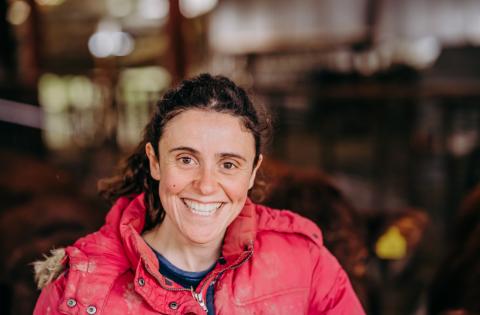EXECUTIVE SUMMARY
Beef farmer launches direct meat sales business after Farming Connect-funded study
A suckler beef producer who has established a direct sales business for meat produced by her family’s Red Ruby Devon herd says farmers who adopt grazing techniques to grow cattle slowly need to be incentivised with grants that reflect the benefits from this approach.
Kathryn Tarr embarked on a Farming Connect Management Exchange programme study to help inform her ambition to establish a box beef system for marketing beef from the native breed herd on the family farm near Builth Wells.
She visited two farms producing Red Ruby Devon beef from different systems and who sell the majority of the meat directly to customers through boxes.
“As a farm more used to selling commercial cattle as stores, it was important to me to find out whether selling the traditional breed Ruby Red Devons as beef boxes could compete financially with the store trade,’’ said Ms Tarr, who also farms 750 ewes on 162 hectares of grassland and hill ground.
“I could sell a good Charolais-cross store at 18 months for about £1,200. I would need to have a mark-up reflective of the extra time and costs taken if I take a Red Ruby to finishing at between 24 and 30 months.’’
The study confirmed that to reflect the additional costs of slaughter, butchering, packaging and marketing, there needed to be a markup of at least a £500 on the market value of the finished animal.
Since her study, Ms Tarr has established her business and invested in a website to market the boxes - one of the businesses she visited for her study, the Northmoor Meat Company, recommended that this was the best way to reach more customers.
The visit also concentrated her mind on how her cattle should be reared.
“I was really impressed with the set up at the Northmood Meat company and would like to think about finishing my beef sometime in the future on grass,’’ she said.
“I am interested in rotational grazing and am putting the infrastructure into the farm in order to implement it, such as getting the fencing better and thinking about water availability.’’
Ms Tarr had also enrolled on the Farming Connect Master Grass course to learn more about rotational grazing techniques.
She said there is good reasons why beef farmers who finish their cattle less intensively should be incentivised, to offset the cost of selling them simply as stores.
“There need to be grants available so that farmers are able to use techniques such as rotational grazing, and their end product of quality beef needs to be recognised as being added value,’’ she said.
The industry must also highlight the differences between British and imported beef to consumers.
“The farms that I went to demonstrated high animal welfare standards and low food miles,’’ she said.
“They are great example of excellent environmental policies and traditional farming methods coming together to create a quality end beef product.’’
The consumer also needs to better understand whether they are buying beef from a slow grown traditional breed or a faster finishing Continental.
“There should be an understood premium attached to the traditional slow grown beef and the public should understand the difference between grass fed and pasture fed beef because it is all very confusing,’’ she reckoned.
“Pasture fed beef, where the animal has only been fed grass all its life, should really be more of a gold standard than the much talked about organic beef.’’
Ms Tarr also believed that a movement towards eating quality meat as opposed to quantity was needed.
“There is a lot of misinformation about the way in which British beef is produced and British cattle take the blame repeatedly for global warming while people conveniently forget all the other factors at play.
“Small farms need to sell their farming story so that farming is not demonised as the major contributor to global warming and the public can see all the good farmers do to look after the landscape and environment, and the passion that goes into each product.’’
MANAGEMENT EXCHANGE REPORT:


